#25-12 The Incredible Edible Oyster, Part 1. Ecology of an Ecosystem Engineer
In which the E@L shares the secrets of this succulent shellfish
“Oyster, n. A slimy, gobby shellfish which civilization gives men the hardihood to eat without removing its entrails!” ― Ambrose Bierce
One who examines an oyster shell for the first time could easily mistake it for a rock, and might be surprised to discover that, not only is it an animal, but a delightfully delicious one at that.
Oysters are most wondrous animals. Though they seem to lack common animal characteristics – legs, faces, movement, personality – they make up for it in sheer amazingness. A naïve oyster inspector would be forgiven for not knowing that: a) it was an animal, b) it began life as a microscopic swimming larvae, c) they can smell the presence and sex of other oysters, or d) they can change their sex to meet the needs of the local neighborhood. We mostly just appreciate the beauty (and hardness) of its shell, and, when eaten, the slimy, briny, crunch and salty sea flavor.
Oysters are a big subject – so big that I can’t do them justice in one post, so this is the first of a three-part series. In Part One, we explore the biology and ecology of oysters; in Part Two we will cover the history of oyster exploitation and the Oyster Wars (yes, you read that correctly), and in Part Three, we will delve into oyster restoration and politics.
The Eastern Oyster
The Eastern Oyster, Crassostrea virginica, is also known as the bluepoint, or Chesapeake Bay oyster. The most important thing to know about them is that they create large reefs consisting of millions of shells all cemented together.
Oyster reefs are unique ecosystems. Prior to colonial settlement in America, oysters accumulated over millennia, forming multi-acre structures 6 to 10 m in height (20-33 feet). Some of these reefs reached nearly to the surface of the water, forming navigation hazards for early explorers. There were enough oysters to filter the entire Chesapeake Bay in 4 days.
Oysters are “ecosystem engineers” because they create complex architectural structures (reefs or bars) containing a mix of sexes and age/size groups of oysters. Oyster reefs provide a wealth of ecological services. They provide refuge, feeding, and spawning areas for fish, worms, crabs, and sessile organisms like anemones and jellyfish larvae. Oysters filter the water, remove and ingest phytoplankton and silt, and transfer organic material to benthic ecosystems. They stabilize bottom sediments and protect shorelines from waves and erosion.
Oyster Reproduction
Young oysters are predominantly males. After maturing at ages of 3-5 years, they can detect the presence and sex of other oysters around them, and some will then change sex to ensure that there are enough of both sexes for spawning. Oysters are “broadcast spawners” because both males and females spew their gametes (eggs or sperm) into the water. After experiencing cold winter temperatures, females start to spawn when water temperature reaches 20 °C (68 °F). Females release eggs into the water by clapping their shells. When males detect the presence of eggs, they release sperm in a narrow stream.
Fertilization occurs in the water, and the resulting zygote becomes a swimming planktonic Veliger larva that consumes bacteria, protozoans, and phytoplankton. After a week or so, it becomes a D-shaped Protoconch (early shell) with a small foot. After two to three weeks they drop to the bottom and feel around with their foot for an appropriate hard substrate on which to settle. Using chemosensory organs, they can detect bacterial films and ammonia which alert them to the presence of other oysters. Larvae prefer to settle on the underside of oyster shells, ensuring they will be near their neighbors, and will then cement themselves to it. Within two months they will grow to an inch in diameter.
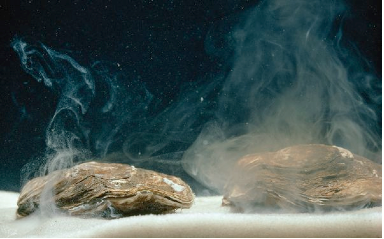

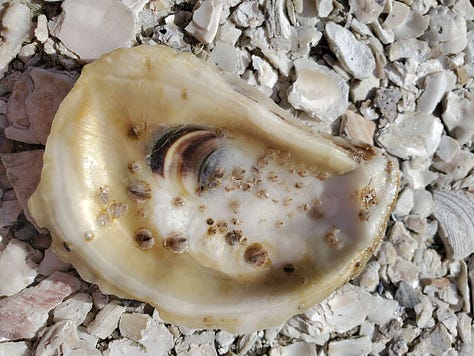
The newly attached oysters are called spat. One female can easily produce a million larvae, which may become 200,000 settled spat. Spat require hard, clean, substrate on which to set, but heavy silt covering (>5 cm) in parts of Chesapeake Bay prevents good settlement. Silt is a combination of runoff from agricultural land, and the bodies of decomposed phytoplankton, the result of excess nutrient pollution.
Oysters are highly beneficial to the marine ecosystem. A recent study demonstrated that one kg of oysters can remove 3.05 kg of nitrogen, 0.35 kg of phosphorus, and 70.52 kg of carbon from the environment, thus oysters have a net positive ecosystem footprint, and net-negative emissions. Denitrification occurs not only via oyster feces deposition, but by bacteria in the oysters, and via other organisms growing among the oyster shells. Carbon sequestration is an order of magnitude higher in oyster farms than in natural ecosystems, supporting the concept of Carbon Sequestration by Shellfish Farming (CSSF) as a marketable asset. Nutrient removal by oyster farms could also be capitalized via a credit system.
Oyster Predators and Pests
Oysters suffer from a variety of diseases. Vibrio is a naturally occurring bacterium that affects larvae in hatcheries and can be treated with antibiotics but rarely causes disease in adults. Adults can die within 2 years of infection by a protozoan called Dermo (Perkinsus marinus), common in the Gulf of Mexico, and to which they have little natural resistance. Dermo infestations increase in summer when water temperatures exceed 75 °F and salinity rises above 12 PSU. Another protozoan pathogen called MSX (Haplosporidium nelson) kills mostly young oysters within a month. This can be limited by timing spat placement prior to outbreaks.
Oyster drills Stramonita haemastoma are snails that drill into the shell with a calcified radula and secrete enzymes to dissolve shell material. They can kill one oyster per week and cause 33% spat mortality. Mud crabs Panopeus herbstii can kill 20 spat/day the same size as their shells. Blue crabs Callinectes sapidus chip away at shells and extract the meat, killing up to 20 spat/day, at sizes up to 35 mm. Other predators include Toadfish Opsanus tau, Summer Flounder Paralichthys dentatus and skates (Raja spp). The boring sponge Cliona celata creates pits in shells by secreting acid; it rarely penetrates completely but induces energy-depleting shell repair and decreases gonad size and meat yield. Seastars, Asterias forbesii can kill 25% of spat by secreting an anesthetic that causes the oyster to gape, then inserting their stomach to digest the meat.
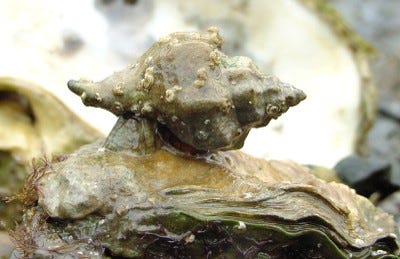
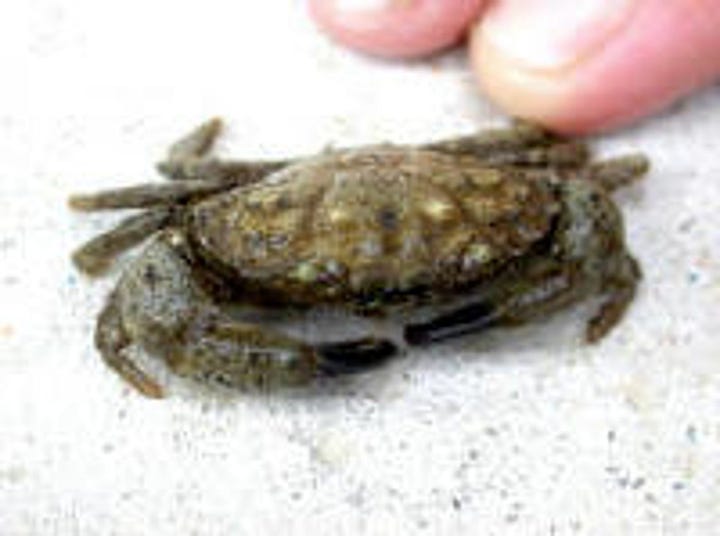
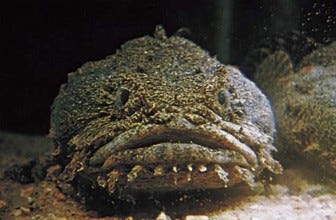
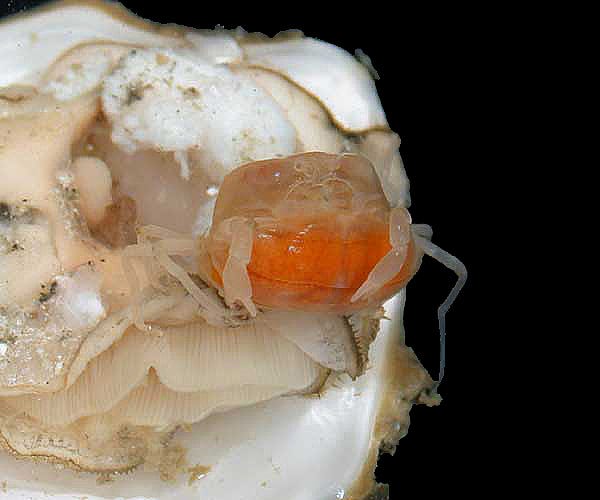
If you are a fan of raw oysters you will eventually encounter the pea crab or oyster crab Zaops (Pinnotheres) ostreum, a soft-shelled crab that lives in the body of a bivalve. Hosts are usually oysters, but the crabs can also live in mussels and scallops. Technically they are a type of kleptoparasite because they steal food from their hosts but otherwise don’t do much harm. Many oysters can have two or more pea crabs in them. They are most common in wild oysters in warmer waters, such as the James and York Rivers in Chesapeake Bay. They are rare in farmed oysters that originate from hatcheries, or in cold-water oysters, so you are unlikely to find one in your half-shells at your local oyster bar.
Pea crab larvae invade their hosts in late summer. After a year, the males exit and enter shells with females to mate, whereas females never leave, and mature after 2-3 years. Large adults rarely exceed 10 mm in width. Restaurants may pick them out, but their presence actually indicates good refrigeration. A pea crab cookbook published in 1901 featured 16 recipes. You can eat them raw, battered and fried, or steamed with mayonnaise.
Oyster Facts & Fables
You might have heard several of these “rules” about oysters, but let’s examine them carefully.
Fact or Fable? You should only eat oysters in months with an “r” (Sept-April, or Argust, in my area). Fable. While there may have been historic reasons for this rule, they are no longer valid. European oysters Ostrea edulis brood spat in their shells, so eating them during brood season could give you a mouthful of crunchy little shells. Historically, poor refrigeration caused oysters to spoil quickly in summer, but that problem has been solved by improved technology. Additionally, oysters typically spawn in early summer, after which they are thin and watery, and not very palatable. But cultivated triploid oysters do not spawn, so they stay fat and juicy year-round. So, you no longer need to worry about summer oysters, but if you want the freshest, tastiest oysters, winter is still the best season to eat them.
Fact or Fable? An oyster can filter up to 50 gallons of water per day. Fact. I’m not sure of the source or accuracy of this statement, but they can filter a large amount of water. A time-lapse video of this process can be seen here.
Fact or Fable? More big oysters will produce more little oysters. Fable. Although this is one argument for oyster conservation, there is no scientifically proven relationship between the numbers of adult oysters and spat settlement, except to say that NO oysters will produce NO spat. This is true for most marine invertebrates, especially broadcast spawners that produce millions or billions of larvae. The reason they are so productive is because larvae have an extremely low chance of survival to adulthood and are highly subject to environmental variation. Differences between good and bad spat years are primarily due to vagaries in weather conditions.
Fact or Fable? Oyster dredging “tills” the bottom like farmers till cropland. Fable. Watermen claim that dredging turns over the oysters and removes layers of silt, but this argument is highly doubtful. Dragging dredges over oyster reefs has reduced most of them from tens of feet in height to flat layers of single oysters on the bottom. Unfortunately, this idea has never been scientifically tested, probably because there are so many other problems with oysters that deserve more attention.
Thanks for sticking with me through this mashup of molluscan misinformation. In the next episode we will learn that oysters were responsible for a type of Eastern Shore gold rush, a lawless environment with enslaved oystermen, a reign of bloodshed called the Oyster Wars, and the creation of a dedicated Oyster Navy to quell the violence.
This issue of Ecologist at Large is available to all readers. However, if you would like to support my work with a one-off contribution, click “Buy me a coffee” below.







To each their own (oyster). More coming on restoration in Part 3.
I visited a marine research lab for a tour and got to look at some of the oyster stages you mention. Learned a lot of new things from you - can’t wait to read the next two parts!